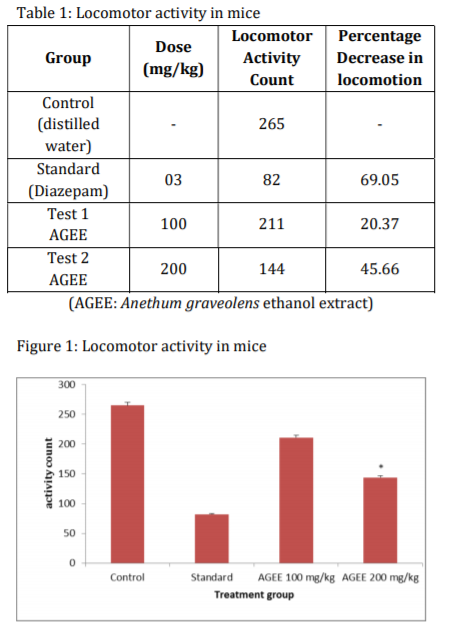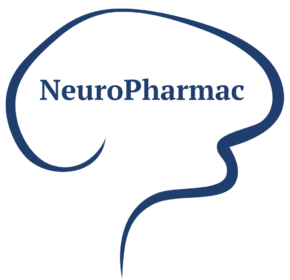Department of Pharmacology, College of Medicine, Shaqra University, Shaqra-11961, Saudi Arabia.
Ethnopharmacological relevance: seeds of Anethum graveolens have been used in the Indian traditional medicine to relieve stress and other neurological disease conditions. Aim of the study: The present study was under taken to evaluate the anxiolytic effects of seeds of Anethum graveolens Ethanolic Extract (AGEE) in mice. Materials and methods: Seeds of Anethum graveolens Ethanolic extract was screened for anxiolytic effect by using using locomotor activity at doses of 100 and 200 mg/kg. Distilled water and Diazepam were employed as negative and positive control groups, respectively. Results: Anxiolytic effect assessment of seeds of Anethum graveolens Ethanolic Extract (AGEE) 200 mg/kg shows significantly decrease in locomotion (45.66 %) as compared to standard (69.05 %) treatment group. Conclusion: The results of this study established a support for the traditional usage of seeds of Anethum graveolens as anxiolytic medicinal plant.
Anethum graveolens L is a member of umbelliferae family. Many properties of dill such as antibacterial, [1] antioxidant, [2] antihypercholesterolemic, [3] and cancer chemo-preventive effects, [4] have been reported. In folk medicine, it is commonly used to improve gastric irritation, indigestion, stomachache, insomnia, and colic. [5] Dill decreases sexual potency and spermatogenesis in males. [6-8] Depression and anxiety are the most frequent mental isorders. More than 20% of the adult populations suffer from these conditions at some time during their life. The World Health Organization predicts that depression will become the second leading cause of premature death or disability worldwide by the year 2020. Approximately two- thirds of the anxious or depressed patients respond to the currently available treatments but the magnitude of improvement is still disappointing. Then, the medical need for newer, better-tolerated and more efficacious treatments remains high. [9]present study was conducted to eavaluate traditional claim of plants as used in depression.
Experimental Animals
Swiss albino mice of male sex weighing 22–28 g were used. Animals were maintained under standard conditions in an animal house approved by Committee for the Purpose of Control and Supervision of Experiments on Animals (CPCSEA). Institutional Animal Ethics Committee approved the experimental protocol. The animals were given standard diet. The animals had free access of standard diet and water and housed in a spacious cage for one week. Mice were housed in cages of 5 at 22 ± 1◦C in a 12- h light/dark cycle. Tap water and food pellets were available as libitum. Groups of 6–11mice were randomly assigned to different treatment groups and were tested in a counter balancing order. Animals were naive to experiment conditions. All experiments were carried out during night cycle of light and the experiments were carried out according to the National Research Council Guide for the Care and Use of Laboratory Animals [10]. All experiments were conducted in accordance with international standards of animal welfare recommended by the Society for Neuroscience [11]. The experimental protocol was approved by the Bioethical Committee on Animal Research. The minimum number of animals and duration of observations required to obtain consistent data were employed.
Drugs and Chemicals
The positive controls were: Diazepam (Calmpose Tablet, Ranbaxy, India) was used as standard drug for anxiolytic effect and purchased from respective source. Ethanol (Hi Media, India) propylene glycol (Hi Media, India) was purchased from the respective sources and was of analytical grade.
Treatment
The ethanol extract of Anethum graveolens was freshly dissolved in distilled water to be acutely administered to the rats. Doses of the extract and the time intervals were determined in preliminary tests. Imipramine (10 mg/kg) was dissolved in distilled water. Negative control groups received only distilled water. All administrations were performed intraperitoneally (i.p.) in a dose volume of 1 ml/kg body weight. Thirty minutes after i.p. treatment, the animals were submitted to a battery of behavioral tests.
Source of dill Seeds
seeds of Anethum graveolens (dill) were collected from farm house. The identity of the seed was confirmed by the Institutional Botanist. A voucher specimen was kept in laboratory for future reference.
Preparation of Aqueous Extract
Dried dill seeds were homogenized to a fine powder. Hundred grams of powdered coriander was Infused in 500 ml cold ethanol for 24 h, brought to the boil, then removed from the heat source and allowed to infuse for 15 min. The extract was filtered, concentrated over the water bath and brought to dryness under vacuum. The yield of the extract was 8.7% (w/w).
Acute toxicity study
Acute toxicity study was performed using the limit test dose of 2000 mg/kg as described by Organization for Economic Cooperation and Development guideline and Interagency Research Animal Committee recommendation [11]. Six female mice were dosed sequentially and followed for any signs of toxicity and/ or death within 24 h and then for 14 days thereafter.
Locomotor Activity
Locomotor activity was recorded individually for each animal in Opto-Varimex cages (Columbus Instruments, USA) linked on-line to a compatible IBM-PC. The behavior of the rats was analyzed using Auto-Track software (Columbus Instruments, Columbus, USA). Each cage (43 cm× 44 cm × 25 cm) was equipped with a 15 × 15 array of infrared emitters located 3 cm from the floor surface. The number of light beams interrupted by an animal was recorded at 5 min intervals and was presented as the distance traveled in cm. [9, 12]

Acute toxicity test
At a single oral dose of 2000 mg/kg, seeds of Anethum graveolens Ethanol Extract showed no signs of toxicity or death in mice within the first 24 h and during the 14 days observation period.
Locomotor activity
The effects of AGEE on locomotor activity count are shown in table 1 and figure 1. AGEE 200 mg/kg elicited significant reduction in locomotor activity count as compared to the control. Anxiolytic like activity assessment of seeds of Anethum graveolens Ethanolic Extract (AGEE) 200 mg/kg by using actophotometer shows significantly decrease in locomotion (45.66 %) as compared to standard (69.05 %) The effect of treatment with CSEE on the locomotor activity count was dependent of the dose.
Antidepressant disorders comprise a major public health problem are the most prevalent psychiatric disorders worldwide. Because of the fact that the synthetic drugs are endowed with a plethora of problems; these arch for therapeutic alternatives has been conducted largely by means of the study of medicinal plants. In this context, there has been a resurgence of interesting medicine from natural sources with the hope that drugs of plant origin will have significantly lesser side effects than that observed with synthetic drugs while having comparable efficacy. In the present study, anxiolytic effects of seeds of Anethum graveolens Ethanolic extract were evaluated using locomotor activity on mice models, in which AGEE 200 mg/kg elicited significant reduction in locomotion count as compared to the control.
The present study investigated the putative behavioral effects of the seeds of Anethum graveolens Ethanolic extract. Thus, doses of 200 mg/kg of the extract produced a significant decrease in locomotion activity. The results of this study established a support for the traditional usage of seeds of Anethum graveolens as anxiolytic medicinal plant.
References
- 1.Delaquis PJ, Stanich K, Girard B, Mazza G. Antimicrobial activity of individual and mixed fractions of dill, cilantro, coriander and eucalyptus essential oils. Int J Food Microbiol. 2002;74(1- 2):101–9. [Google Scholar] [PubMed]
- 2.Satyanarayana S, Sushruta K, Sarma GS, Srinivas N, Subba Raju GV. Antioxidant activity of the aqueous extracts of spicy food additives–evaluation and comparison with ascorbic acid in in-vitro systems. J Herb Pharmacother. 2004;4(2):1–10. [Google Scholar] [PubMed]
- 3.Yazdanparast R, Alavi M. Antihyperlipidaemic and antihypercholesterolaemic effects of Anethum graveolens leaves after theremoval of furocoumarins. Cytobios. 2001;105(410):185–91. [Google Scholar] [PubMed]
- 4.Zheng GQ, Kenney PM, Lam LK. Anethofuran, carvone, and limonene: potential cancer chemopreventive agents from dill weed oil and caraway oil. Planta Med. 1992;58(4):338–41. [Google Scholar] [PubMed]
- 5.Hosseinzadeh H, Karimi GR, Ameri M. Effects of Anethum graveolens L. seed extracts on experimental gastric irritation models in mice. BMC Pharmacol. 2002;2:21. [Google Scholar] [PubMed]
- 6.Duke JA. Handbook of medicinal herbs. 2nd ed. London: CRC Press; 2002. [Google Scholar] [PubMed]
- 7.Weiss RF. Weiss’s herbal medicine. New York: Thieme; 2001. [Google Scholar] [PubMed]
- 8.Monsefi M, Ghasemi A, Alaee S, Aliabadi E. Effects of Anethum graveolens L. (dill) on Oocyte and Fertility of Adult Female Rats. Journal of Reproduction & Infertility. 2015;16(1):10-17. [Google Scholar] [PubMed]
- 9.Aslam Pathan. et al. Neurological Assessment of Seeds of Coriandrum sativum by Using Antidepressant and Anxiolytic like Activity on Albino Mice. Inventi Impact: Ethnopharmacology, 2015(3):102-105, 2015. [Google Scholar] [PubMed]
- 10.Handbook for the Use of Animals in Neuroscience Research, 1997 (updated 18-July-97). http://apu.sfn.org/content/Publications/Handbo okfortheUseofAnimalsinNeuroscienceResearch/H andbook.htm. [Google Scholar] [PubMed]
- 11.Organization of Economic Co-operation and Development (OECD). The OECD Guidelines for Testing of Chemical: 423 Acute Oral Toxicity, France, 2001. [Google Scholar] [PubMed]
- 12.H Gerhard Vogel, Drug discovery and EvaluationPharmacological assays, Second edition, Springer Publication, Germany 2002, 430. [Google Scholar] [PubMed]

